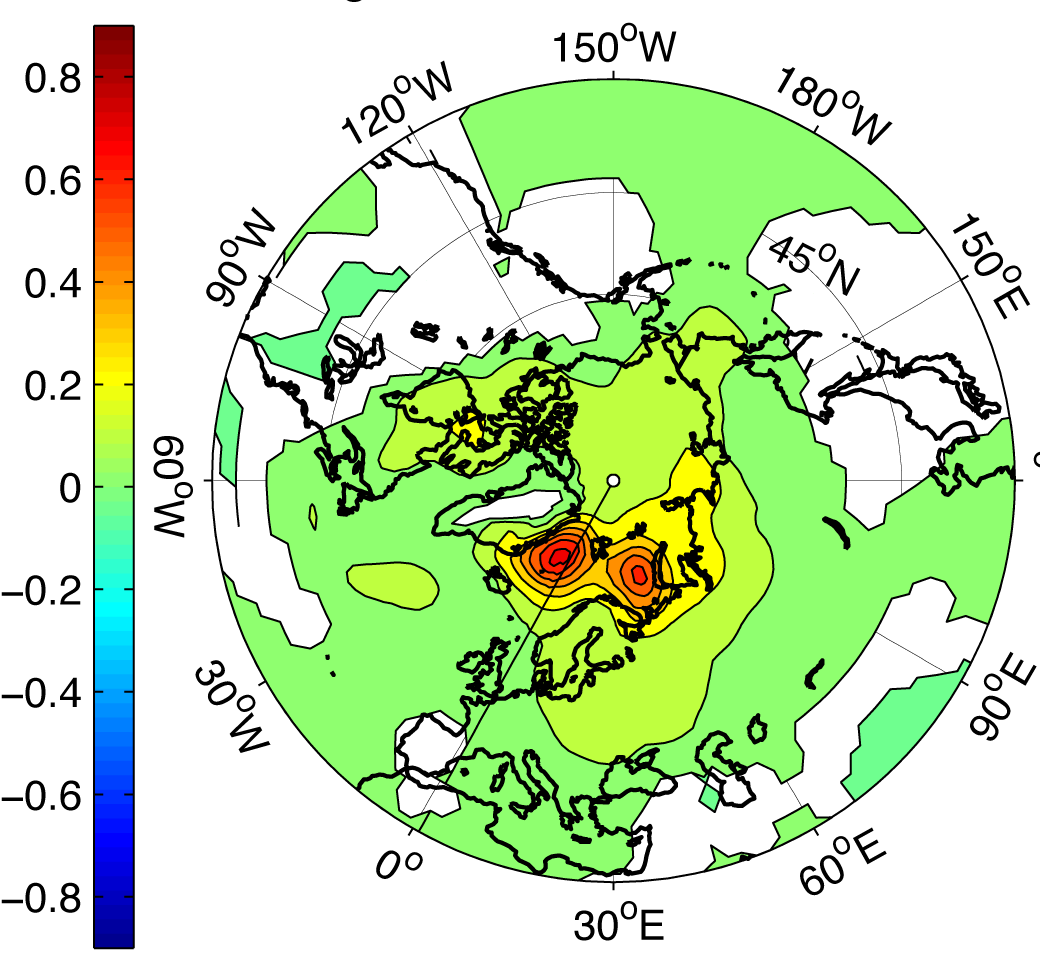Warm climates have dominated the past 65 million years of Earth history. Understanding why these past warm climates existed is critical for understanding the consequences of current and future global warming. DYNAWARM investigates how warm conditions on Earth are created and maintained by combining reconstructions of past warm climates, global model simulations of past and future warming, and studies of the physical processes contributing to polar warmth to answer questions such as:
Heat transport to high latitudes
In 1964, Jacob Bjerknes proposed that fluctuations in heat transported around the climate system by the ocean should be approximately balanced, or compensated for, by fluctuations in heat transported by the atmosphere. This so-called “Bjerknes Compensation” has been found in the control run of the Bergen Climate Model, with fluctuations in oceanic and atmospheric transport that are highly correlated on decadal timescales. The spatial signature of these fluctuations in surface air temperature has a dipole structure for the Northern Hemisphere, highlighting regions in which surface climate is strongly influenced by heat transports as well as ocean–atmosphere interactions. Critical regions are the Barents, Kara, and Nordic Seas, where the marginal sea ice allows for extremely strong fluxes between the ocean and atmosphere.
Pliocene
Of the numerous warm climate periods in the geologic record, the Pliocene (5.3–2.6 million years ago) is a particular focus because it represents an equilibrium analogue for the present climate (CO2 concentrations similar to those expected at the end of this century and global mean temperatures 3°C warmer than today). Previously, the Nordic Seas were thought to be over 6°C warmer than today. New records suggest that Pliocene sea-surface temperatures were no more than 2–3°C warmer than present interglacial temperatures, but with an altered pattern of ocean circulation despite the similarities in continental configuration and radiative forcing.

Late-glacial and Holocene
The onset of the Bølling–Allerød interstadial in the late-glacial and the onset of the Holocene represent two major warming events in the last 15,000 years. Terrestrial biotic responses to these warmings are a combination of population expansion, migration, and niche shifts, and a few local extinctions. Responses to the Younger Dryas cooling and the late-Holocene cooling after the Holocene Thermal Maximum are primarily local or regional extinctions. Regional climate-model simulations for Europe at 6000 and 200 BP indicate increasing climatic sensitivity to anthropogenic deforestation. Challenges are thus to disentangle biotic responses to late-Holocene climatic changes
per se, to direct human activity, and to a combination of drivers.
Cryosphere
Potential thresholds in the cryosphere (sea ice and ice sheets) are a concern in today’s warming world. One question is how sea ice will be affected by projected increases in river runoff to the Arctic Ocean. Modelling experiments reveal a complicated oceanic response. More runoff strengthens the protective surface layer and stabilizes the upper ocean; at the same time, the surface layer thins, allowing the underlying warm Atlantic water to move up towards the base of the ice. Another question is how the Greenland ice sheet will respond to a warmer climate. The most recent period with high-latitude temperatures warmer than today is the last interglacial (~130–115 thousand years ago). Under last interglacial climate conditions, ice-sheet model simulations show Greenland melting. This melting occurs mostly on the margins, while the central height of the
ice sheet decreases by only a few hundred metres. The total amount of melting depends largely on the initial size of the ice sheet and reaches ~1–3 m in sea-level equivalent.

